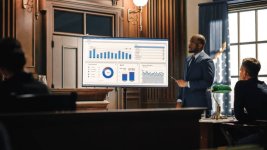Traditionally, courtrooms relied on physical documents, verbal testimony, and printed photos to present evidence. However, with the rise of computer graphics, the legal industry has experienced a shift in how information is visualized and communicated. Today, attorneys and legal experts increasingly use graphics and animations to strengthen their arguments and help judges and juries better understand complex cases.
This transformation is not just about aesthetics—it’s about clarity, engagement, and persuasion.
Legal proceedings often involve technical evidence, whether it’s explaining how a crime occurred, showing the timeline of events, or visualizing financial data. Using computer graphics in legal contexts helps:
Using 3D graphics, experts can recreate a crime scene based on photographs, witness testimonies, and forensic data. This helps jurors see how events unfolded, including angles, positions, lighting, and movements.
In personal injury or insurance cases, computer graphics simulate car crashes, workplace accidents, or environmental disasters. These visuals offer a neutral, science-backed reconstruction that can be persuasive in both defense and prosecution.
When injuries, surgeries, or internal damage need to be shown, medical graphics (such as animated organ movement or fracture diagrams) can offer clarity that words cannot.
In complex lawsuits with many actors or events, animated timelines and interactive diagrams help organize the case structure. These can be updated in real-time as new facts emerge.
Fraud, embezzlement, or contract disputes often involve financial evidence. Charts, heatmaps, and data animations clarify patterns and show digital paper trails.
While graphics can be powerful, their use in legal proceedings must follow strict ethical and admissibility standards:
Courts often scrutinize computer-generated evidence more closely to ensure it is fair and factual.
Computer graphics have been used in high-profile trials involving:
They are also increasingly used in civil lawsuits, arbitrations, and depositions.
Have you ever seen computer graphics used in a courtroom or legal documentary?
Do you think visual evidence can make trials more fair, or more biased?
Should courtrooms adopt more tech like this for transparency?
Let us know your thoughts in the comments!
This transformation is not just about aesthetics—it’s about clarity, engagement, and persuasion.
Why Computer Graphics Matter in Law
Legal proceedings often involve technical evidence, whether it’s explaining how a crime occurred, showing the timeline of events, or visualizing financial data. Using computer graphics in legal contexts helps:
- Simplify complex data and events
- Engage juries with visual storytelling
- Make facts more memorable and understandable
- Reconstruct events with accuracy and visual logic
Applications of Graphics in Courtroom Presentations
1.Crime Scene Reconstructions
Using 3D graphics, experts can recreate a crime scene based on photographs, witness testimonies, and forensic data. This helps jurors see how events unfolded, including angles, positions, lighting, and movements.
2. Accident Simulations
In personal injury or insurance cases, computer graphics simulate car crashes, workplace accidents, or environmental disasters. These visuals offer a neutral, science-backed reconstruction that can be persuasive in both defense and prosecution.
3. Medical Illustrations
When injuries, surgeries, or internal damage need to be shown, medical graphics (such as animated organ movement or fracture diagrams) can offer clarity that words cannot.
4. Timelines and Case Flowcharts
In complex lawsuits with many actors or events, animated timelines and interactive diagrams help organize the case structure. These can be updated in real-time as new facts emerge.
5. Data Visualizations
Fraud, embezzlement, or contract disputes often involve financial evidence. Charts, heatmaps, and data animations clarify patterns and show digital paper trails.
Advantages of Graphics in the Courtroom
- Better Comprehension: Jurors may not have technical or medical backgrounds. Graphics help bridge the gap.
- Neutral Representation: When developed by third-party experts, visuals add credibility and neutrality.
- Increased Retention: Visual content is more memorable than verbal content, aiding in deliberation.
- Time Efficiency: Long, complex explanations can be condensed into quick, clear visuals.
Legal and Ethical Considerations
While graphics can be powerful, their use in legal proceedings must follow strict ethical and admissibility standards:
- Accuracy is critical: Any distortion may be considered misleading.
- Expert validation: Simulations must be backed by qualified professionals.
- Disclosure: Visuals must be shared with opposing counsel before the trial.
Courts often scrutinize computer-generated evidence more closely to ensure it is fair and factual.
Tools Used in Legal Graphics
- TrialDirector – Software for organizing and presenting evidence visually
- 3ds Max / Maya – For realistic 3D reconstructions
- SmartDraw / Lucidchart – To create timelines and diagrams
- Adobe Illustrator – For professional visual aids and annotations
- MedLegal Visuals – Specialized service for medical graphics in law
Real-World Impact
Computer graphics have been used in high-profile trials involving:
- Road accidents (to simulate crash dynamics)
- Patent infringement cases (to show 3D product models)
- Homicide trials (to recreate shooting angles and sequences)
- Financial fraud cases (to map money flow between accounts)
They are also increasingly used in civil lawsuits, arbitrations, and depositions.
Join the Conversation
Have you ever seen computer graphics used in a courtroom or legal documentary?
Do you think visual evidence can make trials more fair, or more biased?
Should courtrooms adopt more tech like this for transparency?
Let us know your thoughts in the comments!

